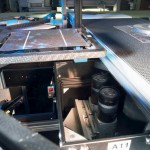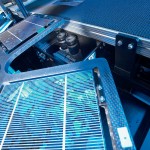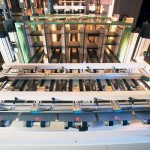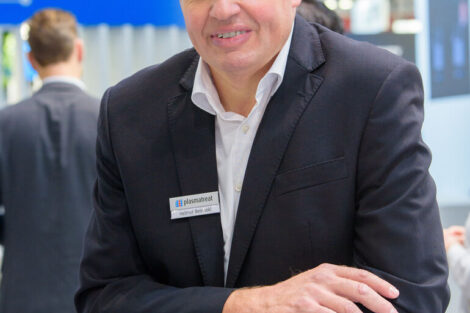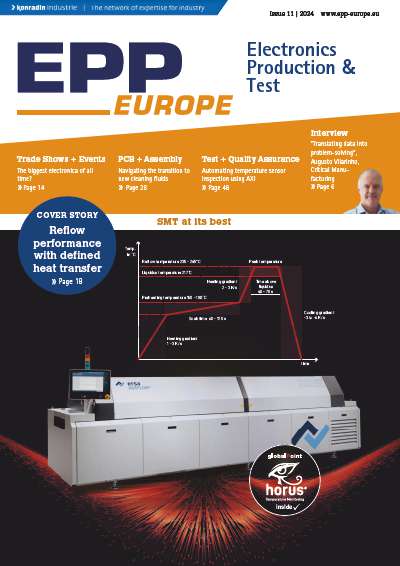Whether for one’s own use or for feeding into the grid, solar and photovoltaic plants are gaining in popularity in both private and commercial sectors. The high demand for these systems necessitates efficient, fully automated production and testing processes for solar cells. Maximum throughput rates can only be achieved, however, with dependable detection sensors – one of the main reasons why Schmid Technology Systems, a leading manufacturer of machines for solar cell production, uses powerful WTB4–3 photoelectric proximity switches from Sick in, for example, its C-Sort 5000 solar cell sorter.
The sensors meet a variety of extreme demands: space-saving miniature housing, simplest possible installation and commissioning, electrical and mechanical compatibility with other physical operating principles (such as ultrasonic sensors), but above all the reliable detection of the extremely difficult solar cell surfaces, even when the light and reflection conditions in the machine background are far from ideal. All these features were of paramount relevance for those responsible for construction and production in the Schmid Group.
Leaders in innovative fields of business
The strategic realignment of Schmid from a producer of wood processing machines to the up-and-coming electronics industry began in 1965, shortly after the company’s 100-year jubilee, with their first brushing machine for circuit boards. Today the Schmid Group develops and produces individual and complete systems for the solar/photovoltaic, circuit board and flat panel display sectors with about 1,500 employees at 13 sites worldwide. The company’s production area totals almost 100,000 m² – part of which is to be found at the Niedereschach works. This is where Schmid Technology Systems manufactures equipment for wafer and cell production as well as modules for the solar/photovoltaic sector, e.g. the C-Sort 5000 sorter, an inline module for measuring and sorting up to 5,000 solar cells per hour. After a variety of layers have been deposited in different wet-chemical, plasma and thermal processes – creating the semiconductor structure and photosensitivity of the solar wafer – the wafers undergo sunshine simulation, print image inspection and inspection of the back of the wafer in the sorter’s three measurement stations. For this purpose, the solar cells are fed into the sorter via a wide transport belt with up to five lanes. Integrated FlexPicker robots take on the handling of the cells before and after the inspection stations until they are sorted into more than 40 different quality classes. The sorter’s complete automation, and the numerous transfer and handling steps within the module, require reliable detection of the individual solar cells and the polystyrene foam boxes (within which the solar cells of a single quality class are stacked after reaching the maximum permitted level in the sorter) that are diverted out of the sorter via a linear system.
Photoelectric proximity switch
Most of the sensors that underwent a variety of tests were incapable of coping with, in particular, detection of the solar cells – sometimes only 160 µm thick. The cell surface is provided with a phosphor emitter, given an anti-reflex coating and then metallised. In optical terms, therefore, the solar cells are deep blue, almost black, and have a remission of below 1 % – the transmitted light of a photoelectric proximity switch is thus almost entirely absorbed. At the same time, the uneven polycrystalline structure of the solar cells generates extremely variable light reflections. In addition, the anodic coating of the machine parts and hoods on and in the C-Sort 5000 sorter results in a high level of light interference. Taken together, this means that the photoelectric proximity switch must be able to detect almost “invisible” objects while having enormous immunity to reflections from the surroundings. This was best achieved by the WTB4–3 from Sick. This photoelectric proximity switch can detect particularly small, transparent or reflective objects (depending on the area of use) with a high level of reliability, and independent of the object’s colour or surface properties. Objects in, or pulses from, the background do not impair reliable function because the devices’ new ASIC chip developed by Sick allows a hitherto impossibly precise background suppression. Reflections thus have just as little effect on reliable function of the devices as electromagnetic sources of interference, flash lamps or vibrations. At the same time, blind zones in short-range detection are also a thing of the past with the WTB4–3. Moreover, its miniature housing and simple mounting ensure easy integration – regardless of space limitations within the machine.
Universal use plus alternatives
At Schmid Technology Systems, the WTB4–3 is not only used for the demanding detection of solar cells, but throughout the sorter for position detection as well as checking presence and height within the sorter. Schmid also exploits the advantages offered by the WTB4–3 having the same platform as the UC4 ultrasonic series from SICK. Thus, where backgrounds move a great deal it is possible to change from the optoelectronic system to the more stable acoustic functional principle in individual cases – and thus profit from the same mechanical and electrical connection concept.
Turnkey solutions
Turnkey solutions are one of the strengths of the Schmid Group. Thus Schmid Technology Systems logically relies on a “turnkey supply” for the automation segment – and purchases not only these two sensors from a single source, but also rotative encoders and high-end camera systems for 3D inspections. The DRS61 incremental encoder, whose zero impulse is electronically assigned by pressing a button, is used for continuous path measurement on the sorters’ transport belts. With this device, the machine constructor can parameterise a single basis version with all line numbers between 1 and 8,192 themselves via PC, according to the application, and thus solve the most varied of tasks. This results in reduced warehousing and rapid availability because it is no longer necessary to stock or purchase machine- or application-specific device versions. Moreover, the desired zero pulse width (90 ° or 180 °) can also be individually defined. In operation, differential scanning by means of the ASIC scanning element in the encoder results in high immunity to interference and excellent signal quality. The Ranger image processing system ensures maximum precision during inspection of the back of the solar cells in the sorter. It sets the standard for 3D object measuring inspections in industrial environments, where it provides a maximum scanning rate of up to 35,000 profiles per second. Each profile can consist of more than 1,500 highly precise pieces of 3D data with a height resolution down to below a few micrometers. With its patented multiscan function, a Ranger camera is even capable of simultaneously capturing several different images of the same object: 2D measurement, determination of 3D height profiles, and the generation of scatter images – with information on the object’s surface structures as well as those just below the surface.
Photoelectric proximity switch with IO Link expands automation potential
The WTB4–3 photoelectric proximity switch used by Schmid Technology Systems for all their automation products offers interesting possibilities for meeting future requirements – thanks to its IO Link option. The sensor switching signal has been expanded to create a communication interface, allowing receipt of both binary information as well as comprehensive service data from machines – without a separate bus system or additional cable. During operation, parameters such as the sensor’s scanning distance or hysteresis are parameterised, controlled and visualised via the automation system. If there is a problem, a machine operator or maintenance employee can immediately form an impression of the possible cause because all the important diagnostic information is immediately displayed, e.g. the signal quality in figures and as a bar display, the status of the switching output, the display of any possible short-circuit, and information on any influence from other sensors. This information also allows preventive maintenance of plants like the C-Sort 5000 sorter during a break in operation – preventing downtimes caused by unplanned machine standstills.
Conclusion
With the WTB4–3, Schmid Technology Systems is using a sensor solution that offers maximum reliability during solar cell detection as well as interesting new automation potentials for the future.
EPP Europe ###
ZUSAMMENFASSUNG
Solar- und Photovoltaik-Anlagen liegen im Trend. Die hohe Nachfrage erfordert effiziente und durchgängig automatisierte Herstellungs- und Prüfprozesse für Solarzellen. Höchstmögliche Durchsatzleistung ist jedoch nur mit zuverlässig erfassender Sensorik möglich. Mit dem leistungsstarken Lichttaster setzt der Solarzellen-Hersteller eine Sensorlösung ein, die ein Höchstmaß an Sicherheit bei der Solarzellen-Detektion bietet.
Les installations solaires et photovoltaïques sont à la mode. La demande élevée nécessite des processus de fabrication et de contrôle efficaces et largement automatisés pour les cellules solaires. Cependant, des capteurs fiables sont indispensables pour obtenir un rendement optimal. Avec le puissant capteur de lumière, le fabricant de cellules solaires opte pour une solution procurant un maximum de sécurité dans la détection par cellule photoélectrique.
Gli impianti solari e fotovoltaici sono di tendenza. La richiesta elevata richiede processi produttivi e di controllo delle celle solari efficienti e completamente automatizzati. Una produzione elevata può essere raggiunta solo con sensori di acquisizione affidabili. Gli efficienti sensori a tasteggio consento ai costruttori di celle solari di utilizzare una soluzione in grado di offrire la massima sicurezza di rilevamento delle celle solari.
Share:




